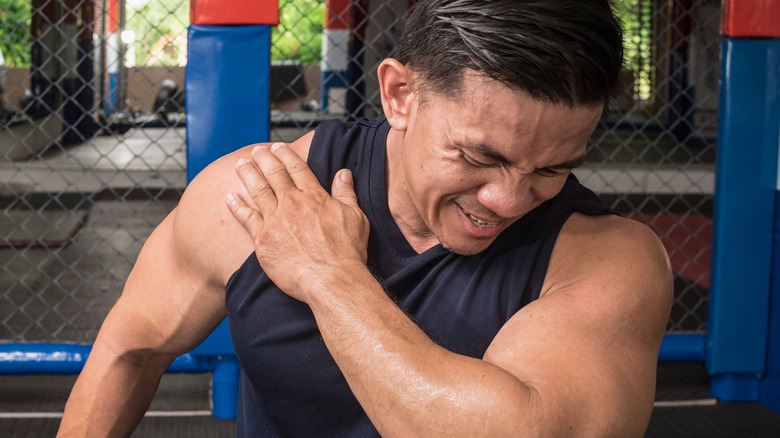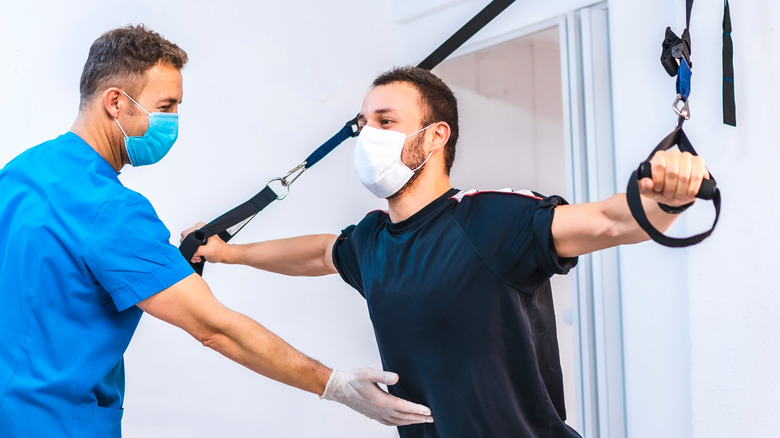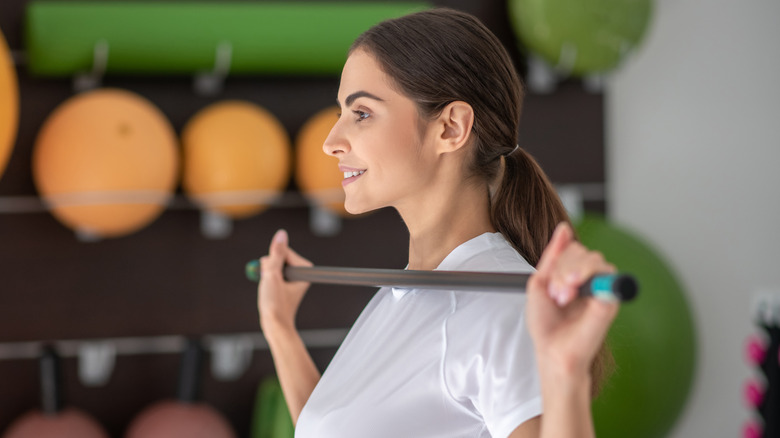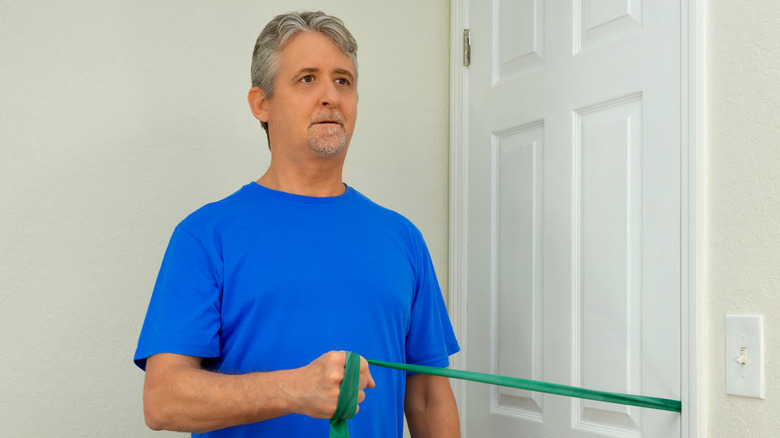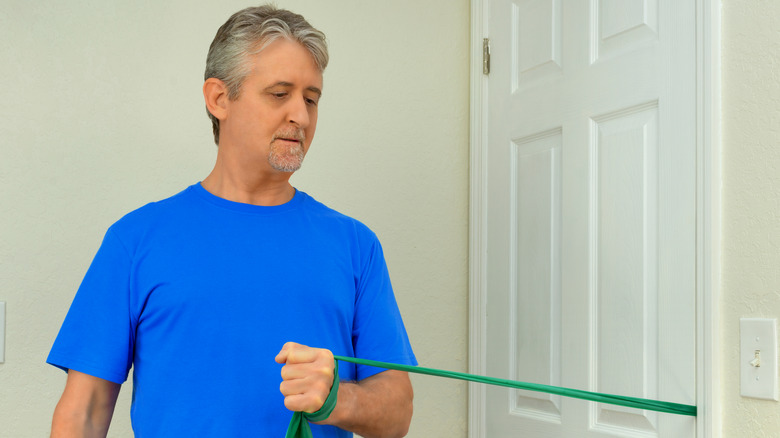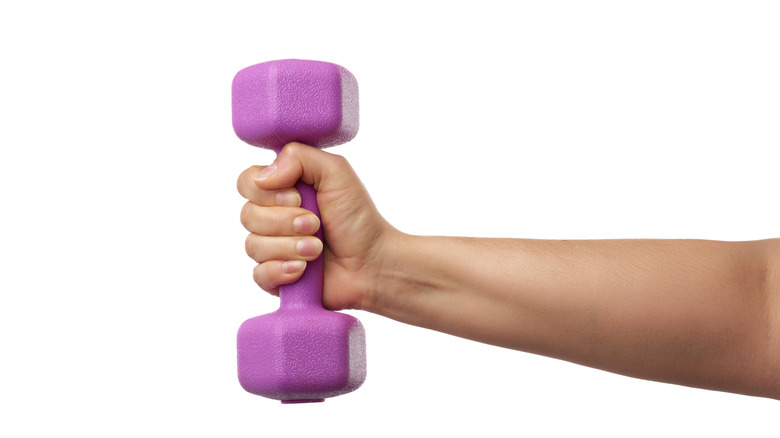The Best Workouts To Strengthen Your Rotator Cuff
Shoulder pain can be common because the shoulder joint has a wide range of motion, according to Penn Medicine. We can easily get an impingement in the rotator cuff when we wear down the tendons or muscles through overuse or age (via Healthline). The muscles or tendons can get inflamed and pinch between the bones of the arm and shoulder. The rotator cuff isn't just one muscle or tendon but four muscles that wrap around the shoulder. These muscles are called the supraspinatus, infraspinatus, teres minor, and subscapularis (per Physiopedia).
According to WebMD, many problems with your rotator cuff don't need surgery. Instead, you can treat rotator cuff pain first by resting the shoulder and applying ice where there is pain. You can also take an anti-inflammatory until the swelling goes down. You can help your rotator cuff heal and prevent future injuries by stretching and strengthening the muscles and tendons of the rotator cuff (via Healthline). Here are a few stretches and strengthening exercises to keep your shoulders strong and mobile.
Doorway stretches and the pendulum
The doorway stretch can help you warm up the muscles in the rotator cuff before your strengthening exercises (per Healthline). Find an open doorway and extend your arms to each side. Grabbing onto the sides, slowly lean forward to feel the front of your shoulders and chest stretch. If possible, lean forward even more until you come onto your toes. Because this is the opening stretch, try not to stretch too far.
For the pendulum stretch, you'll need a counter, table, or chair to lean on for support. This stretch will focus on the deltoids, supraspinatus, infraspinatus, and subscapularis (via OrthoInfo). Lean your right arm on the support, and allow the left arm to drop. Like a pendulum, swing the left arm back and forth and side to side. You can also do circles with your left arm. After you've loosened the left arm, repeat with the right arm.
Passive internal and external rotations
For the next two stretches, find a yardstick or light bar. The first stretch will target your subscapularis, and you'll feel it on the front of your shoulder (per OrthoInfo). With the stick in your right hand, reach it behind you below your waist with your palm facing away from your body. Now reach your left arm behind you with the palm facing away from the body and grab the other end of the stick. Move the stick horizontally to the right and hold for 30 seconds to work the left side. Then you can move the stick to the left to stretch the right shoulder.
The second stretch will put your shoulder in an external rotation to stretch the infraspinatus and teres minor. Using the same stick, hold it with your palms facing up and elbows bent 90 degrees. Move the stick to the right and hold for 30 seconds, then repeat on the left side. Be sure to avoid twisting your torso. You should feel this working the back of your shoulder (per OrthoInfo).
Standing external rotation with a resistance band
For this exercise, you'll need a resistance band and something secure (like a doorknob) to loop the band around at waist height. This exercise will work your infraspinatus and teres minor, so your upper back and the back of your shoulder should feel the work (via OrthoInfo). Hold the open end of the band and bend your elbow 90 degrees. Your elbow and hand should be the same height as your shoulder and out to the side. Your knuckles should be facing the secured end of the resistance band.
While keeping your elbow elevated, draw the resistance band up in an arc until your knuckles face the ceiling. Lower your forearm back to the same level as your shoulder and elbow and repeat for eight repetitions. You can work the other arm for a set of eight, but complete three sets. Once eight repetitions get easy, work in additional reps until you can do three sets of 12.
Standing internal rotation with a resistance band
This internal rotation exercise will work the pecs in your chest and the subscapularis in your shoulder (via OrthoInfo). Keeping the resistance band attached, stand 90 degrees to the right of the secured post. Hold the opposite end of the resistance band in your left hand, which should be closest to the post. Bend the left elbow 90 degrees and hold your upper arm close to your side. Your forearm should be directly in front of your body, and your knuckles should face toward the right.
Keeping your elbow pressed against your side body, pull the resistance band towards your stomach. That's one rep, and repeat until you've completed eight reps. You can turn towards the other side to work your right side, but complete three sets. Work up to 12 repetitions to strengthen these muscles. You can also do these exercises with a cable machine at a gym.
Lying external and internal rotations
The last two exercises require a light dumbbell, and you'll start by lying on your right side. With the dumbbell in your left hand, bend your elbow 90 degrees and fix it to the side body. While keeping your upper arm stable, raise the dumbbell vertically toward the ceiling. Hold the weight steady for a second or two, then slowly return to the starting position. Complete 10 reps on one side, then roll onto your left side to work the right arm. Aim for three sets of 10 at first, and shoot for 20 reps over time (via Healthline).
You can also work the internal rotators on the front of your shoulder using the same dumbbell (via OrthoInfo). If you start on your right side, grab the dumbbell in your right hand and bend your right elbow 90 degrees. The top of your arm and elbow should remain at your side. Lift the weight towards the ceiling, then lower it back to the floor. Complete eight to 10 repetitions before moving to the left side. Start with two sets at a lighter weight, and work towards three sets of five over time.

